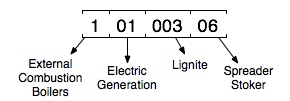EPA uses Source Classification Codes (SCCs) and area and mobile source (AMS) codes to classify different types of anthropogenic emission activities. SCCs have 8 digits for point sources, while AMS codes have 10 digits, and sometimes include a leading “A” as an eleventh character. In SMOKE, we refer to both kinds of codes as “SCCs”, and we ignore the leading “A” in the area and mobile codes. Additionally, SMOKE permits the nonpoint and point toxics inventories to use both 8-digit and 10-digit SCCs in the same inventory input file, because both 8- and 10-digit codes are contained in the nonpoint and point inventories in the 1999 NEI for HAPs. The maximum field width in SMOKE and its input files for SCCs is 10 characters.
The codes use a hierarchical system in which the definition of the code gets increasingly more specific as you move from left to right. It is important to understand the hierarchy of the codes, because you can take advantage of the hierarchy in building cross-reference files for assigning emissions processing factors to inventory emission sources. In the diagrams below, level 1 is the least specific and level 4 is the most specific.
The code structure for the 8-digit point-source codes is:

An example point-source activity and corresponding SCC can be taken directly from SMOKE’s SCC description file (SCCDESC): “External Combustion Boilers; Electric Generation; Lignite; Spreader Stoker” is represented by 10100306. Below we have mapped the levels of this description with the levels of the SCC:

Similarly, the code structure for the 10-digit area- and mobile-source codes is:

SMOKE treats SCCs as character strings, though in practice the values in the inventories and cross-reference files are usually numeric. In Section 2.4, “Cross-referencing and profiles” on cross-references and profiles, we explain how these hierarchies are used by SMOKE and how you should use them in preparing SMOKE input files.
For on-road mobile sources, SCCs are treated somewhat differently than for other source categories. We explain more about this in Section 2.8.4.1, “Special approach for on-road mobile MOVES SCCs”.